Let’s start 2021 with a proven strategy for grabbing two growing income streams in one buy. Plus, we’ll nicely set ourselves up to bank double-digit price gains to boot.
The strategy? Simple: we’re buying dividend-paying stocks poised to spin off one of their businesses into a brand-new dividend-paying stock. When that happens, we wind up with two or more quarterly dividends where there used to be just one.
Two other things you should know: our “new” dividend(s) will likely grow faster than our original payout! And we won’t have to do anything to get this extra cash.
I’ll give you a telltale sign to look for as we move to front-run the next “dividend split” in a moment. But first, let’s look at how spinoffs are, hands-down, the closest thing you’ll ever find to a win-win in investing.
How Spinoffs Can Deliver Triple-Digit Gains, Accelerating Payouts
Medical-equipment maker Abbott Labs (ABT) and its spinoff, pharmaceutical firm AbbVie (ABBV), are classic examples of the gains (and fast-growing dividends) a spinoff can hand us.
Prior to their breakup eight years ago, the dividend of the old parent company, Abbott, was already growing at a healthy clip, more than doubling in the preceding 10 years and reaching $0.51 a share right before the spinoff took effect:
Abbott’s Dividend Soared Pre-Split …
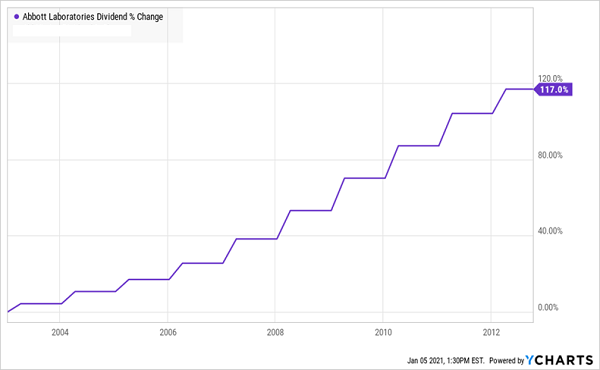
On the day of the split, Abbott investors were handed one share of AbbVie for every Abbott share they owned, and the new firm set its payout at $0.40 a share quarterly.
Abbott, for its part, had reduced its payout to $0.14 a share to account for AbbVie’s dividend, so investors now had two dividend streams that paid them $0.54 a share in all—more than the $0.51 they were getting from the “old” Abbott.
It got better, too, because the spinoff lit a fire under the payout, with both firms’ dividends nearly tripling in eight years, growing 176%, on average, much faster than the old Abbott’s payout grew in the preceding decade.
… And Both Firms’ Payouts Accelerated After …
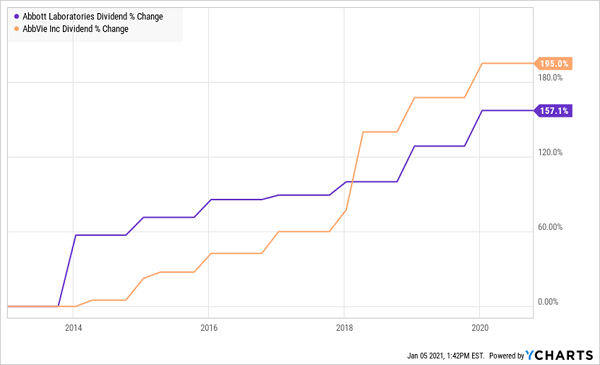
And if Abbott investors held on to their AbbVie shares, their holdings skyrocketed as other income-seekers noticed these rapid payout hikes and bought in, driving up the prices of both companies in lockstep with their rising payouts:
… Driving Fast Price Gains, Too!
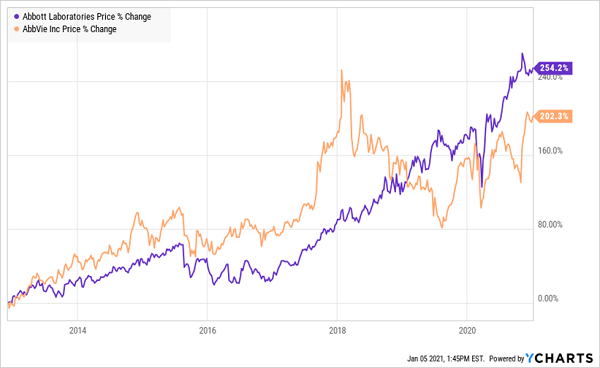
Spinoff + Growing Dividend = Double Win
I think you can see where I’m going here: buying stocks that are about to split and have fast-rising payouts is the key to unlocking some serious profits.
The best news is that, to tap the biggest gains, you don’t have to be clairvoyant: even if you’d bought Abbott and/or AbbVie during the first few months after their separation, you’d have still bagged most of the gains both stocks went on to deliver.
That’s because new spinoffs tend to stagnate for the first while as investors who were handed them get a feel for the new company—and ultimately decide whether they want to keep it around. There’s also a lack of coverage of spinoffs from Wall Street, which would much rather fawn over a shiny new IPO than a “boring” spinoff.
But spinoffs have advantages IPOs lack: for one, many have already proven they’re profitable businesses. And their parents will also want to help ensure they get off on the right foot, because they won’t want to be known for a spinoff that fell flat.
IPOs, on the other hand, are rarely profitable, have no access to the management expertise of a parent company and, let’s be honest, never pay dividends! I’m looking at you, Airbnb (ABNB) and DoorDash (DASH).
And make no mistake, growing dividends are critical to our strategy—as AbbVie and Abbott showed, you can set yourself up for outperformance if you grab shares of upcoming or recent spinoffs with a history of hiking their payouts.
The One Telltale Sign of an Upcoming Spinoff
Pretty well all spinoffs have one thing in common: they come from companies that have one or more divisions whose products don’t overlap with one another. You can see this with AbbVie, whose pharmaceuticals are separate and distinct from Abbott’s medical devices.
You can see it again with one of the biggest spinoffs in stock-market history, the split of online-payment service PayPal (PAYPL) from auction site eBay (EBAY).
Companies that conduct spinoffs also tend to grow by buying other firms, as was the case with information-technology manager Synnex (SNX), which we added to the portfolio of my Hidden Yields dividend-growth service in October 2019.
We did so because this growth stock was trading “too cheaply” thanks to its recent acquisition of customer-service consultant Convergys. Higher debt levels had spooked Mr. and Ms. Market, as the couple fretted whether SNX could pay its tab.
But we anticipated that SNX, which has made 24 acquisitions in its 40-year history, would have no problem paying down the credit for its latest shopping spree. Since then, the firm steadily reduced its debt and its stock steadily rose. We Hidden Yielders have enjoyed 52% total returns since we added SNX to our portfolio:
Spinoff Play Shines for 52% Total Returns
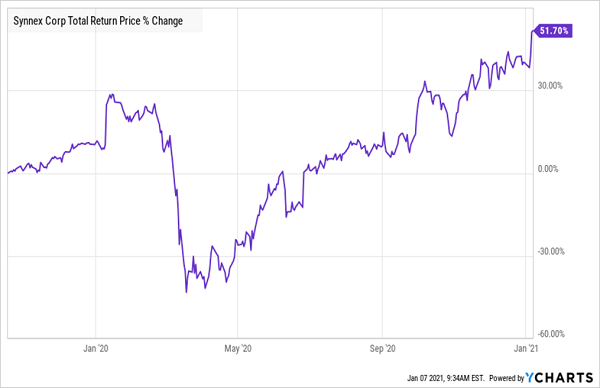
That’s not all: just over a month ago, Synnex completed the spinoff of Concentrix Corporation (CNXC), which provides customer-service solutions and works with many of the top tech companies in the US. And guess what? We’re already up 27% on our new CNXC position.
Spinoff “Baby” Surges Post-Split

That’s a great start, and I’ll have more to say about both stocks in Hidden Yields once we get a clearer sense of how big—and how fast-growing—Concentrix’s dividend will be, as well as Synnex’s payout growth post-pandemic.
Meantime, one spinoff to keep an eye on is the one in progress at International Business Machines (IBM), which will conclude before the end of 2021. The new firm will contain IBM’s IT infrastructure business, letting the “old” IBM focus on artificial intelligence and cloud computing. The move will better position IBM to take on cloud leaders Microsoft (MSFT) and Amazon.com (AMZN).
No word on the new company’s dividend, but management says two firms’ combined payouts won’t be less than the $1.63 quarterly (for a 5% annualized yield) IBM pays today.
What I See Ahead for Synnex and Concentrix—and 7 BUYS for 130%+ Upside
I’ll give you my current buy/sell recommendations on Synnex and Concentrix right now when you “road test” Hidden Yields for 60 days with no obligation whatsoever. And you’ll be among the first to get any changes in my advice as the companies’ post-spinoff picture gets clearer.
The instant you start your trial, you’ll get VIP access to the Hidden Yields portfolio, including my latest buy or sell recommendations on these two stocks, plus the names of 17 other solid dividend growers we’re holding now, too.
And that’s not all: I’ll also give you an exclusive special report naming my 7 best buys for your portfolio as we kick off 2021.
These 7 picks are all doing exactly what we need them to right now: kicking out huge yearly dividend increases that are attracting more and more investors—who are bidding up their stocks in lockstep with their ballooning payouts!
Buy These 7 Stocks Now—Before Their Next Dividend Hike
Pick No. 1 is a great example. It boasts a portfolio of cell towers that are cranking out higher and higher rents as each of us gobbles up more and more mobile data (especially during the pandemic).
And management is turning around and handing that surging cash stream to its investors as a dividend that rises every quarter and has jumped an amazing 137% in the last 5 years. That, in turn, has driven its share price up almost point for point as more investors have come onboard:
137% Dividend Hike Ignites Pick No. 1’s Price
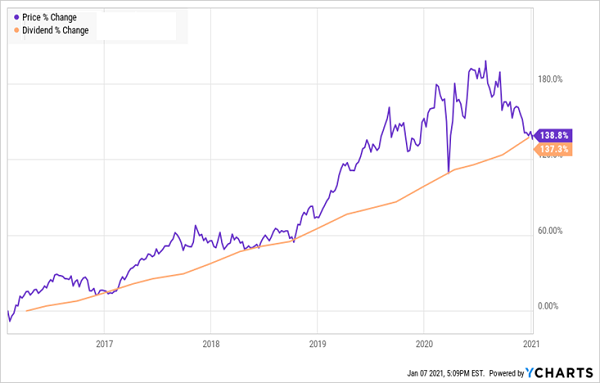
This smartly run company has plenty of cash left for dividend hikes, so we can expect its payout to keep rising higher, taking its share price along for the ride!
The other 6 stocks in this report all have dividends that are surging just like this, and I expect their share prices to ride their payouts up over the next 5 years, too!
The time to buy all 7 is right now. Go here and I’ll give you this exclusive special report, with full details on all 7 of these stout dividend growers. You’ll also get full access to Hidden Yields (including the names, tickers and updated advice on all 19 dividend growers in our portfolio).

Recent Comments